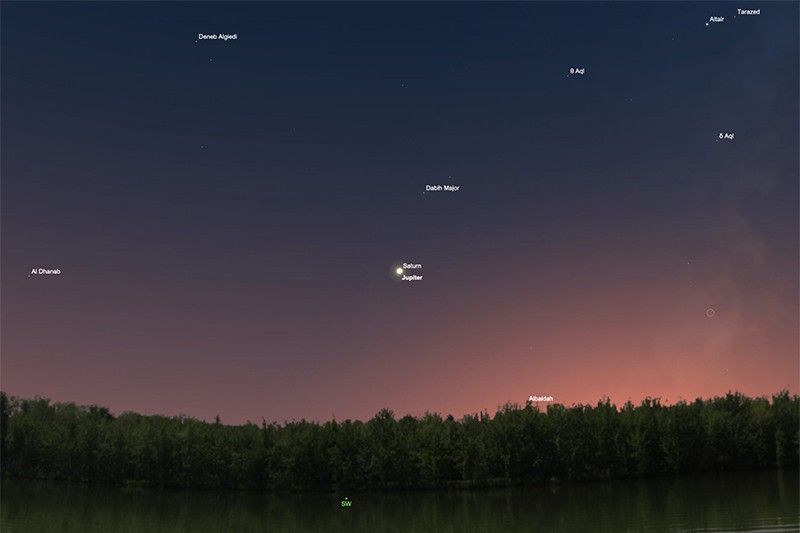What you need to know about 2020 ‘great conjunction’ of Jupiter, Saturn

MANILA, Philippines — The world is about to witness our solar system's two largest planets Jupiter and Saturn appear next to each other at their closest since 1623 and closest visible from Earth since 1226.
The astronomical event known as a “great conjunction” will take place Monday evening, coinciding with the Winter Solstice that marks the time when the Sun lies at its farthest point south of the equator and promises the longest night of the year.
NASA said that Jupiter and Saturn will appear so close "that a pinkie finger at arm’s length will easily cover both planets in the sky." In reality, they will remain spaced apart by hundreds of millions of kilometers.
You wouldn’t want to miss this opportunity since a similar scenario won’t take place for another lifetime away in 2080.
Spectators can spot the planets even without a telescope by observing the southwest right after sunset.
However, we will only be able to see a point of light unless we use a modest-sized telescope to focus on the planets’ features, according to PAGASA Astronomical Observation and Time Service Unit chief Mario Raymundo.
“Ibig po sabihin, kung halimbawa po na-obserbahan natin mamaya itong tinatawag na conjunction of planets, sa naked eye observation makikita natin itong parang single point of light. Pero kung halimbawa gagamit po tayo ng modest... let's say mga 80 millimeter na telescope, ay makikita natin mare-resolve po ito...ito po pala talaga ay ang dalawang planeta na Jupiter at saka ang Saturn,” Raymundo said during PAGASA’s virtual press conference Monday.
(That means, for example, we later observe this so-called conjunction of planets, with naked eye observation we can see it as a single point of light. But if for example we use a modest ... let's say about 80-millimeter telescopes, we will see that it can be resolved... it really is the two planets Jupiter and then Saturn.)
The weather specialist said that permitting clear sky conditions, we will see a point of light around the western horizon around sunset, which is expected around 5:32 p.m. on Monday.
"Lulubog po ito more or less na sa mga 7:45 p.m. Ang pinakamaganda pong observation time ay siguro po mga 6:00 p.m. at saka 7:00 p.m,” Raymundo said.
(It will sink more or less around 7:45 p.m. The best observation time is probably around 6:00 p.m. and then 7:00 p.m.)
Jupiter and Saturn will appear brighter than nearly every star, which means they will be visible even from most large cities.
“Dark skies will allow you to see fainter stars, but Jupiter and Saturn are bright enough that you don’t necessarily need to go to a dark site to take compelling photos of them. If you have a clear view toward the southwest, you have the chance to take some great photos,” NASA advised.
A livestream of the phenomenon from the Al Sadeem Astronomy Observatory is also available below.
- Latest































